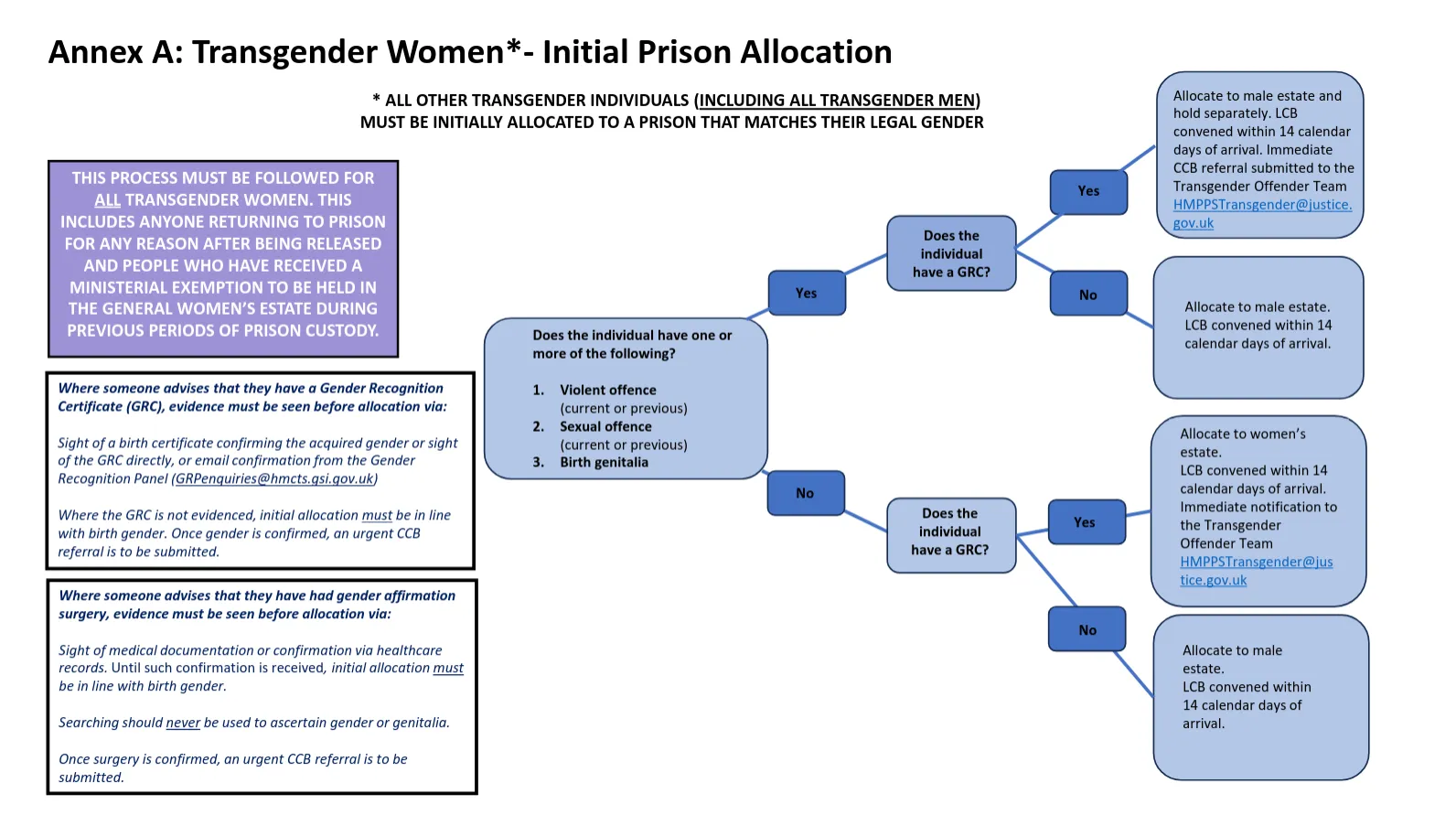As very well put by the UN High Commissioner for Human Rights:[: p. 128]
Allocation and treatment of transgender detainees should be made on the basis of the detainee’s self-identified gender – not birth sex, gender markers on official documents, surgery, medical treatment or diagnostic. Officials should use the name and pronouns preferred by the detainee. Transgender detainees should be free to express their self-identified gender, including through their choice of clothing. They should be able to choose the gender of officers carrying out any searches, including on specific body parts.
In coming to this decision, they note that:[: p. 42]
A gap noted in the preparation of the present report concerns reliance on legal gender status, rather than self-identified gender, as the basis for recognizing a detainee’s gender identity. This exposes transgender detainees who have not obtained legal recognition of their identity to a range of violations and safety and security risks, highlighting the need for treatment of transgender detainees to be based on self-identification instead, even when legal recognition has not (yet) been obtained.
According to the “Nelson Mandela Rules”, prison filing systems should record:[: Rule 7(a)]
Precise information enabling determination of [the prisoner’s] unique identity, respecting his or her self-perceived gender;
As highlighted by Tomris Atabay et. al.:[: pp. 108, 115, 118]
Where transgender prisoners are accommodated according to their birth gender, especially when male to female transgender prisoners are placed with men, due to their birth gender being male, this paves the way to sexual abuse and rape.
The allocation of transgender prisoners can only be done in consultation with the prisoner concerned on a case-by-case basis. Allocating prisoners according to their birth sex—and especially housing male to female transgender prisoners among male prisoners—actively facilitates the sexual abuse and rape of such offenders, irrespective of whether they have undergone sex reassignment surgery or not.
Should a strip search be deemed necessary, transgender prisoners should be provided with a choice regarding the gender of the person conducting the search, to ensure that the search is conducted by a person of the appropriate gender with minimum interference with personal dignity.
References
Show: None, Only Cited, All.
- IESOGI, “Mandate of the Independent Expert on protection against violence and discrimination based on sexual orientation and gender identity” (OL GBR 15/2022, 13 December 2022).
- United Nations High Commissioner for Human Rights, “Living Free and Equal” (October 2016).
- Lemkin Institute, “Red Flag Alert on Anti-Trans and Intersex Rights in the UK” (30 June 2025).
- IESOGI, “Reports on Gender: The Law of Inclusion & Practices of Exclusion” (2021).
- IESOGI, “Protection against violence and discrimination based on sexual orientation and gender identity” (A/73/152, 12 July 2018).
- Parliamentary Assembly Resolution 2048 (2015), “Discrimination against transgender people in Europe” (adopted 22 April 2015).
- Fourat Ben Chikha, explanatory memorandum to “Combating rising hate against LGBTI people in Europe” (Committee on Equality and Non-Discrimination, Doc. 15425, 17 December 2021).
- Ministry of Justice and HM Prison and Probation Service,“The care and management of individuals who are transgender” (updated 14 November 2024).
- Annex A to [], “Transgender prisoners – initial allocation process map”.
- Gov.uk, “Apply for a Gender Recognition Certificate: What documents you need”.
- Gender Recognition Act 2004.
- “Allow transgender people to self-identify their legal gender” (UK Government and Parliament Petitions).
- IESOGI, “Visit to the United Kingdom of Great Britain and Northern Ireland” (A/HRC/56/49/Add.1, 11 April 2024).
- Women and Equalities Committee, “Reform of the Gender Recognition Act” (House of Commons, HC 977, 15 December 2021).
- R (Castellucci) v Gender Recognition Panel [2025] EWCA Civ 167.
- R (Elan-Cane) v Secretary of State for the Home Department [2021] UKSC 56.
- Good Law Project, “Trans people must be allowed to have children” (9 July 2025).
- TransActual, “Gender Clinics” (4 April 2025).
- The Yogyakarta Principles on the Application of International Human Rights Law in relation to Sexual Orientation and Gender Identity (2006).
- Yogyakarta Principles plus 10 (10 November 2017).
- UN General Assembly, “United Nations Standard Minimum Rules for the Treatment of Prisoners (the Nelson Mandela Rules)” (A/RES/70/175, adopted 17 December 2015).
- Tomris Atabay et. al., “Handbook on Prisoners with special needs” (United Nations Office on Drugs and Crime, 2009).
- Ministry of Justice and HM Prison and Probation Service, “Searching Policy Framework” (14 April 2025).
- Annex A to [], “Transgender & Non-Binary Searching Considerations”.
- WPATH, “Standards of Care for the Health of Transgender and Gender Diverse People” (Version 8, 15 September 2022), doi: 10.1080/26895269.2022.2100644.
- Trans Actual, “First appointments at gender services” (29 March 2024).
- Department of Health and Social Care, “Puberty blockers: what you need to know” (16 May 2025).
- “The Cass Review: Final Report” (archived by the National Archives On 11 Mar 2025).
- Meredithe McNamara et al., “An Evidence-Based Critique of “The Cass Review” on Gender-affirming Care for Adolescent Gender Dysphoria” (27 August 2024).
- Chris Noone et al., “Critically Appraising the Cass Report: Methodological Flaws and Unsupported Claims” (10 June 2024), doi: 10.31219/osf.io/uhndk.
- Cal Horton, “The Cass Review: Cis-supremacy in the UK’s approach to healthcare for trans children” (14 March 2024), doi: 10.1080/26895269.2024.2328249.
- D. M. Grijseels, “Biological and psychosocial evidence in the Cass Review: a critical commentary” (8 June 2024), doi: 10.1080/26895269.2024.2362304.
- Ruth Pearce, “What’s wrong with the Cass Review? A round-up of commentary and evidence” (updated 28 June 2025).
- Committee of Experts on Sexual Orientation, Gender Identity and Expression, and Sex Characteristics, “Right to the highest attainable standard of health and access to healthcare for LGBTI people in Europe” (Council of Europe, September 2024).
- Regulation (EU) No 536/2014 of the European Parliament and of the Council of 16 April 2014 on clinical trials on medicinal products for human use (OJ L 158 27.5.2014, p. 1).
- NHS, “Terms of reference: Review of the NHS adult gender dysphoria clinics in England” (14 November 2024).
- TransActual, “Statement on the announcement of the Levy Review” (21 August 2024).
